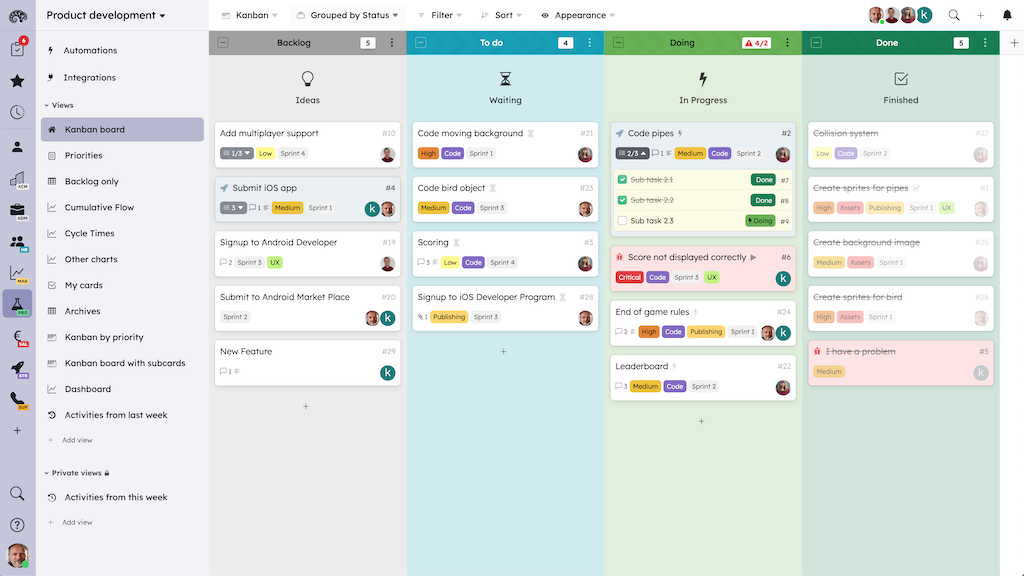To do, doing, done: Introduction to kanban methodology
What is kanban ?
One of the practices that have emerged from or have been assimilated by the agile movement, kanban has grown in popularity in the past 10 years as a change management method to improve the way companies organize their workflow.
In this article, we provide an introduction to kanban methodology, including its origins and evolution, followed by kanban best practices and a few recommended resources for further reading. We also invite you to read our agile manifesto.

Kantree was originally thought of as a tool for kanban, which explains part of our name.
Kanban origins in Japanese manufacturing process
The method can be traced back to the manufacturing industry in post-war Japan, where kanban was used as a signaling system.
More specifically, it originated in the Toyota Production System, which was developed in the 1950s as an implementation of a lean manufacturing system.
Small paper cards called kanban - 看板 in Japanese, meaning signboard - were used to track customer demands and uncover issues in the production flow.
That became the basis for kanban cards you see today in a project management tool like Kantree. The “to do,” “doing,” and “done” cards are commonly used to manage the flow of work.
 Example of a kanban board in Kantree
Example of a kanban board in Kantree
Emergence of kanban method principles
Thanks to the work of software engineer David J. Anderson - who realized that the Toyota method could be applied to any company and work process - and the efforts of the development community, kanban evolved into “an approach to incremental, evolutionary change” for technology development and operations organization.
How does kanban work ?
It is based on four principles, which recommend starting with the current state of the organization, acknowledging what already works well and improving what doesn’t - one step at a time. It also encourages empowering people to make these changes, thus enabling the Kaizen spirit to spread across the company.
Kaizen, or “improvement” in Sino-Japanese, refers to continually improving business activities and involving all team members in the process, from the CEO down.
Here are the four kanban method principles :
1. Start with what you already do
Implementing kanban doesn’t mean making major changes to the way you are organized. It starts by trying to visualize the flow of value in your organization. Then gradually, you can apply small fixes to your current system in order to remove any bottlenecks and maximize the workflow.
2. Apply small changes to your system
Building on the first rule, this one states that changes should be as small as possible, always in a sense of continuity with and evolution of the existing system. This helps reduce resistance due to doubt or fear, which may arise when changes are too abrupt.
3. Respect your existing organizational setup
The kanban way of thinking acknowledges the value that already exists in your organization, such as processes or the roles and responsibilities of team members.
It encourages you to keep (or enhance) what is already working well and only apply changes where it’s truly needed. In other words: no Big Bang. As David J. Anderson states, the principles are meant to help “avoid emotional resistance to change.”
4. Encourage leadership across the company
Here, it’s important to distinguish management from leadership. Everybody (not only upper management) should be encouraged to act as a leader and become one. Leaders are people who are never satisfied with how good their work is and are continually improving. This mindset is referred to as Kaizen, as mentioned earlier.

Kanban best practices
From successful kanban implementations emerged best practices. They were gradually added to the method and are observed to this day.
Here are the three main kanban tips:
1. Visualize your workflow
This principle suggests setting up a tool to visualize and measure how the work flows through your organization. One example is the widely-used kanban board with cards and columns, where each column represents a step in your process and each card a task. Understanding your workflow is a crucial first step before applying changes.
2. Establish a pull system
In order to improve the predictability of your work delivery, you are encouraged to establish a pull system. The idea is that new work is “pulled” into the next step in the process (represented by a column in the kanban board) only when there is available capacity to handle it. This helps eliminate multitasking and instead focus on priorities.
3. Limit work in progress (WIP)
To further improve efficiency, you need to set up work-in-progress limits, so that your flow doesn’t get “stuck” because of too many unfinished tasks (the “doing” column). That is a way to control the workflow and help teams focus on getting things done.
The methodology comes with the following change management advice:
- make policies and processes explicit, so that everyone across the organization is familiar with them and can participate in enhancing them;
- apply a scientific approach to implementing changes in order to reduce uncertainty;
- implement feedback loops (i.e. a mix of best practices, tools, and automation) to continuously monitor your system.

What you should remember about kanban
There are many tried-and-tested benefits of kanban. It’s a great method to:
- evaluate your organization’s work processes and improve them;
- increase delivery speed and predictability through better workflow management;
- end up with happier teams and collaborators, who are committed to your project;
- set up the Kaizen mindset and create a culture of continuous improvement.
It’s worth noting that kanban is not a project management methodology by itself, but it helps you continuously improve your process. And while the kanban board is one of the most famous workflow visualization tools, the method shouldn’t be reduced to it.
Useful resources
What is kanban? by agile consultant Julia Wester. She provides a useful summary of the kanban. Check out her other articles, you will learn a lot about agile methods.
Kanban Applied to Software Development: from Agile to Lean by agile practitioner Kenji Hiranabe. It was back in 2008 that Kenji wrote this great piece on kanban and its origins in Japanese lean manufacturing. It is still worth reading!
Interview with kanban pioneer David J. Anderson: It’s always worth reading David on kanban. Also, check out his blog if you want to stay up to date on the future of kanban.
To go further
3 possibilities offered to you if you have an interest with this subject :
-
1
Try Kantree here, it is free and you don’t need any credit card
-
2
If you want to learn more about how Kantree can adapt to your challenges, make an appointment with an expert on your use case.
-
3
Are you willing to join +1500 professionals receiving our advices and news on digitalization, collaboration, productivity? Register to our newsletter here.
If you enjoyed this article, share it easily down here.